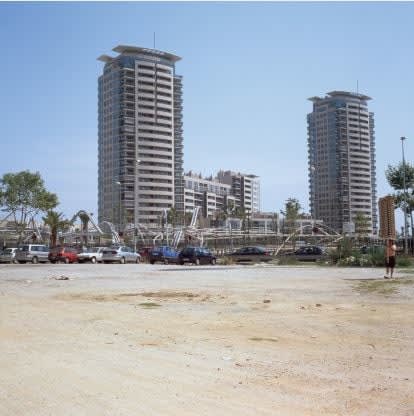Jordi Colomer Spain, 1962
Anarchitekton: Barcelona, 2002
Group of 5 photographs on dibond.
49,5 x 49,5 cm. each; 50 x 50 cm. framed.
Edition of 3
Més imatges
A man hoding a cardboard model runs through the city. He is first in Barcelona, then Bucharest, brasilia and Osaka. His urban journey is endless and seemingly without purpose. A...
A man hoding a cardboard model runs through the city. He is first in Barcelona, then Bucharest, brasilia and Osaka. His urban journey is endless and seemingly without purpose. A solitary figure, his conquest of the world consist only in this “grotesque” journey. A production of utopia.
In the course of his urban pelegrinations, Idroj thus exhibits a maquette which, now and again, is fleetingly identifiable with the building in the backgound, schematically echoing its formal characteristics. This convergence is not systematic, however, for the maquette may also function in a dystopianregister, contrasting wuth the arquitecture and pointing to another reality, to a precariousness that contaminates the official, public or residencial buildings, The maquette instils anarqui into both the order of the real and that of fiction
Anarchitekton could thus be seen as a kind of oxymoron, travestying various kinds of walks in art history, from the practices of the Surrealists to those of the Situationists, by drawing its narrative dimension from the utopian discourse of the architectural avant-gardes. The once trascendent order of arquitecture is now no more than the wild bricolage of space and time. Instruments of measure are reduced to the rank of props in a fiction. Thus, it would seem, there is no “unchanging real,” but only reals. Everything is multiplicity, the coexistenceof intellegible and phantasmagoric fields. Colomer makes sculptures, “sculptures dilated in time.” His works embody the logic of transfer that operates in tales, the reversibility of real and imaginary; they take us back to the absence of origin and foundation, to the aporia of instruments of representation.
In the course of his urban pelegrinations, Idroj thus exhibits a maquette which, now and again, is fleetingly identifiable with the building in the backgound, schematically echoing its formal characteristics. This convergence is not systematic, however, for the maquette may also function in a dystopianregister, contrasting wuth the arquitecture and pointing to another reality, to a precariousness that contaminates the official, public or residencial buildings, The maquette instils anarqui into both the order of the real and that of fiction
Anarchitekton could thus be seen as a kind of oxymoron, travestying various kinds of walks in art history, from the practices of the Surrealists to those of the Situationists, by drawing its narrative dimension from the utopian discourse of the architectural avant-gardes. The once trascendent order of arquitecture is now no more than the wild bricolage of space and time. Instruments of measure are reduced to the rank of props in a fiction. Thus, it would seem, there is no “unchanging real,” but only reals. Everything is multiplicity, the coexistenceof intellegible and phantasmagoric fields. Colomer makes sculptures, “sculptures dilated in time.” His works embody the logic of transfer that operates in tales, the reversibility of real and imaginary; they take us back to the absence of origin and foundation, to the aporia of instruments of representation.










